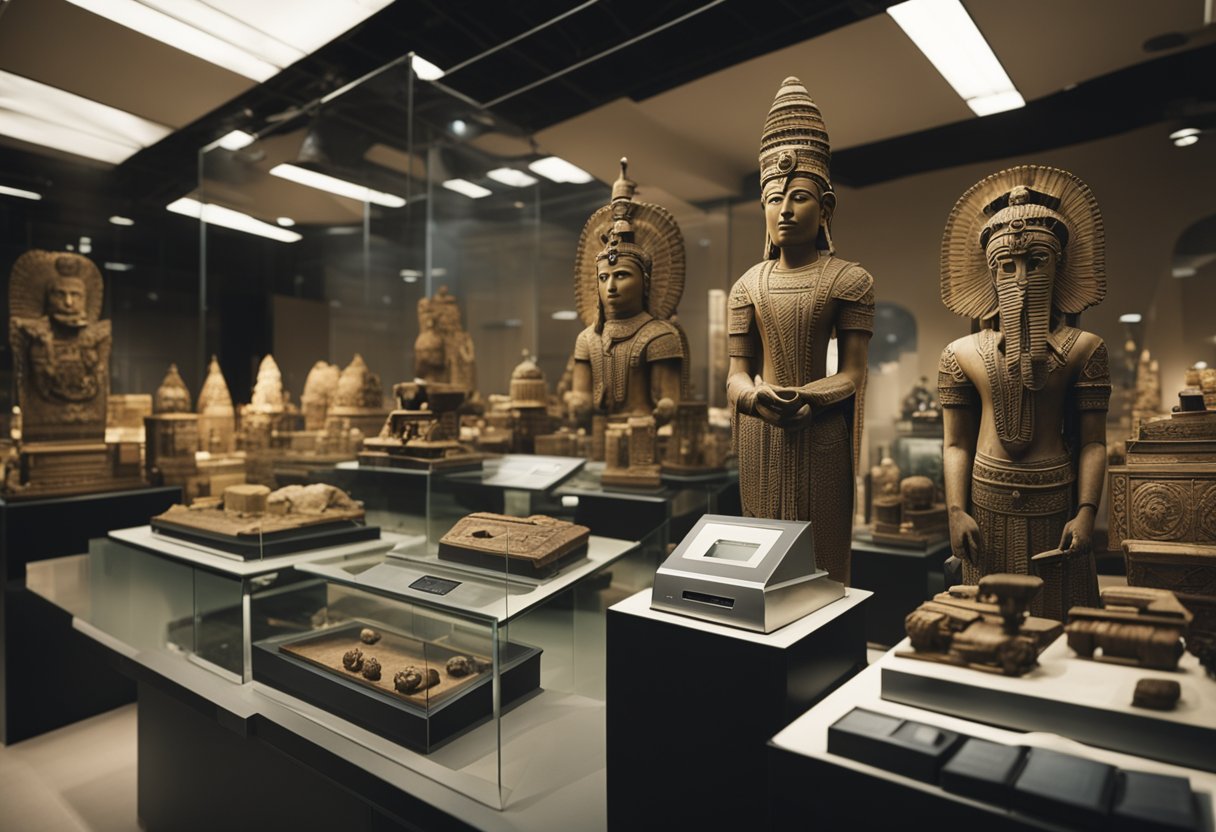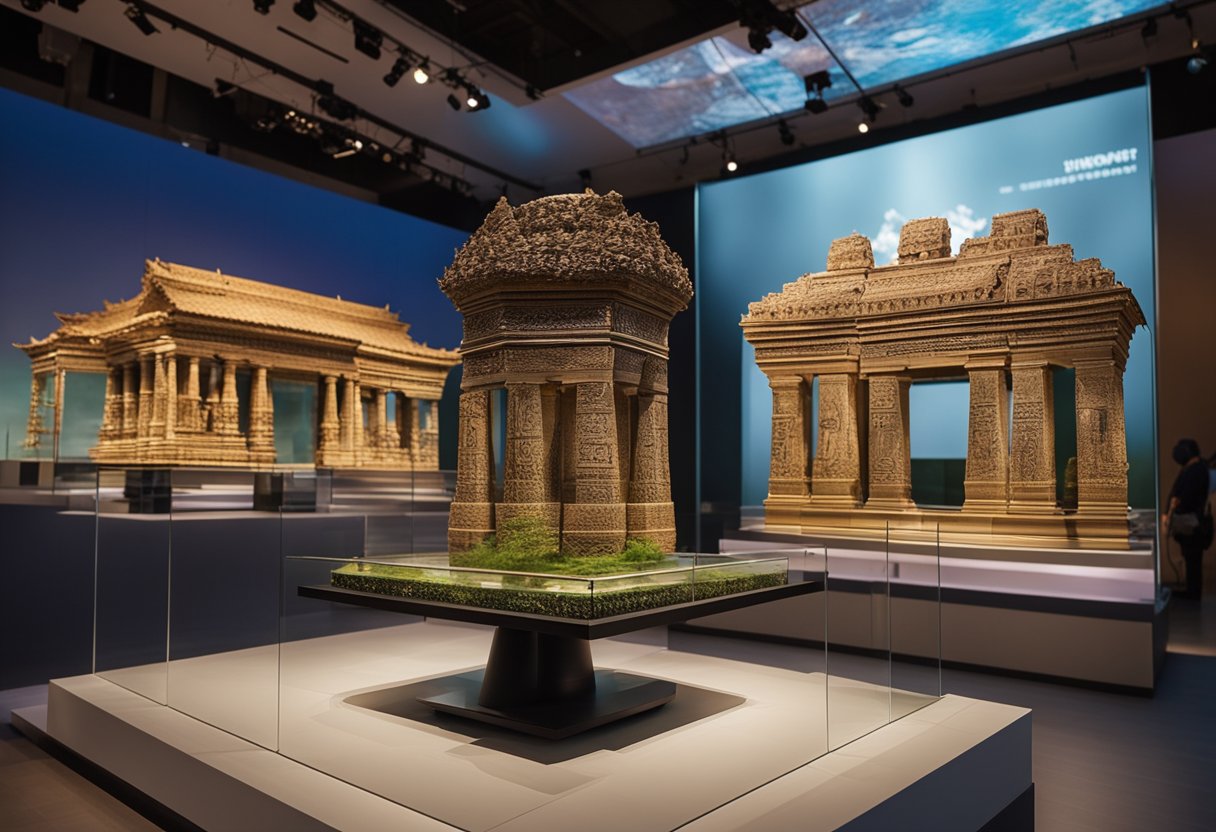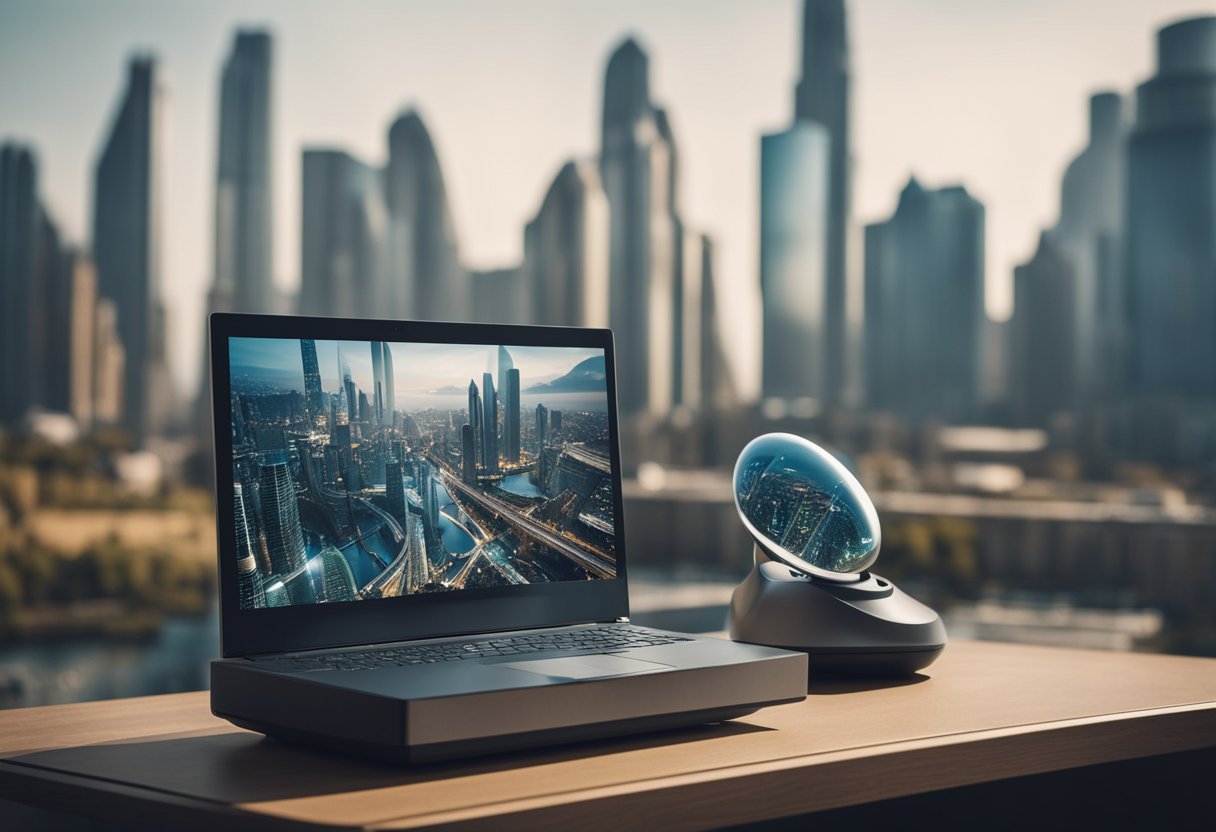Preserving Cultural Heritage in Pixels: How Digital Innovations Safeguard Traditions

Updated On: April 15, 2024 by Aya Radwan
As we witness the relentless march of time, our cultural heritage, that priceless tapestry woven by generations past, is often vulnerable to change and decay. The magnificence of ancient architecture, the whispers of time in art forms and the distant echoes of traditional stories are irreplaceable treasures of the human narrative. Yet, in our modern age, we are not powerless spectators to the threat of their disappearance. Digital technologies have emerged as a vital ally in the quest to document, preserve, and share endangered cultures, ensuring that their stories do not fade into the abyss of forgotten history.
We understand the gravity of preserving cultural heritage, recognising that once lost, the wisdom, identities, and histories encapsulated within are gone forever. Technology offers cutting-edge solutions, transforming conservation efforts by creating detailed virtual records of heritage sites and artefacts. Through meticulous digital archiving, capturing, and reconstruction, we assist in preserving and breathing new life into these cultural gems. This digital safeguarding extends beyond physical preservation, enabling wider dissemination of knowledge and fostering respect and understanding across borders in the digital age.
Historical Context and Importance of Preserving Cultural Heritage
As guardians of the cultural tapestry, we acknowledge the pivotal role of safeguarding the multifaceted narratives of our past. The careful preservation and celebration of our diverse cultural milestones enrich our collective journey.
Defining Cultural Heritage
Cultural heritage encapsulates the spectrum of traditions, customs, artefacts, and values inherited from our forebears. It is the legacy of physical artworks such as monuments, manuscripts, and clothing, complemented by the intangible expression of folklore, language, and rituals. This heritage is not static; it evolves, encompassing the cultural diversity of societies while also providing a cultural context that deepens our connection with history.
Significance in Contemporary Society
Our cultural heritage provides a universal language through which we can appreciate the plurality of human expression. Organisations like UNESCO play a crucial role in recognising and safeguarding both tangible and intangible cultural heritage, fostering an international camaraderie rooted in mutual respect. The instruments and conventions they establish shape our approach to conservation, highlighting that safeguarding our cultural diversity is critical. It informs our identity, enriches our lives in the present, and endows a vibrant, storied world for future generations.
Threats to Cultural Heritage

Cultural heritage faces numerous threats that can lead to irreparable damage or even complete loss. These dangers range from natural deterioration to human-induced pressures. Understanding these threats is pivotal to formulating effective conservation strategies.
Natural Decay and Climate Change
When discussing climate change, it’s important to acknowledge its detrimental impact on cultural heritage. Rising sea levels, extreme weather events, and temperature fluctuations can accelerate the natural decay of irreplaceable historical sites. For example, ancient coastal ruins are increasingly at risk of erosion due to intensified storm surges and flooding.
Human Conflicts and Urbanisation
Urbanisation poses a significant threat to cultural heritage, with the relentless expansion of cities leading to demolishing historic areas. Additionally, human conflicts, such as the destruction caused by ISIS, have resulted in the loss of ancient artefacts and monuments. These actions erase physical structures and the histories and identities they represent.
Erosion of Intergenerational Transmission
The erosion of intergenerational transmission is a less visible but equally critical threat to cultural heritage. As older generations pass away, there is a risk that traditional knowledge, languages, and customs may die with them, particularly in communities undergoing rapid modernisation or facing forced displacement. This loss affects the very fabric of cultural identity and continuity.
Digital Technologies in Heritage Preservation
As we explore the preservation of cultural heritage, it’s evident that digital technologies are not just ancillary tools but are central to safeguarding our collective history. These technologies enable us to capture and immortalise cultural artefacts, sites, and practices in unprecedented ways.
The Rise of Digital Solutions
The advent of digitalisation has spearheaded a revolution in heritage preservation. We’re witnessing a shift from traditional methods to advanced digital techniques that promise greater accuracy and longevity.
- Digitisation converts physical artefacts into digital form, making them accessible to a global audience. This encompasses document scanning, creating digital archives, and recording intangible cultural practices digitally.
- Augmented Reality (AR): By superimposing computer-generated images onto real-world environments, AR provides an interactive experience that brings historical contexts to life, enabling users to gain a deeper appreciation of our cultural heritage.
- Extended Reality (XR) is an umbrella term that covers Virtual Reality (VR), augmented reality (AR), and Mixed Reality. XR is redefining how we interact with cultural content, from museums offering VR tours to online platforms that leverage XR for educational purposes.
From 3D Visualisation to Virtual Realities
The realms of 3D visualisation and VR are perhaps where we see the most significant impact on heritage preservation.
- 3D Visualisation: It involves creating graphical content using 3D software. This particularly impacts the reconstruction of heritage sites and artefacts damaged or lost over time. We can now experience a nearly authentic version of the past, with intricate details brought to life through high-resolution 3D models.
- Virtual Realities: VR immerses users in a fully digital environment, especially when experiencing inaccessible or sensitive heritage sites. We can navigate virtual reconstructions of ancient buildings or landscapes, gaining insights into their historical context without any physical impact on the sites.
These technologies preserve the intricate details of artefacts and historical sites and democratise access, allowing people worldwide to appreciate and engage with our shared cultural heritage from the comfort of their homes. Digital technologies, therefore, are vital in our ongoing endeavour to protect and celebrate the rich tapestry of human history across the globe.
Role of Global and Cultural Institutions
In our efforts to protect and preserve cultural heritage in the digital era, the roles played by global and cultural institutions are pivotal, with programmes and collaborations that span across borders to ensure the future of our past.
UNESCO’s Initiatives and Frameworks
UNESCO, the United Nations Educational, Scientific and Cultural Organisation, stands at the forefront of heritage preservation. It has established numerous initiatives and frameworks that guide cultural heritage site documentation, protection, and sustainable development. For instance, the World Heritage Convention is instrumental in promoting the identification and preservation of cultural sites of outstanding value to humanity. UNESCO’s role is not merely supervisory but also educational, providing resources for capacity building and promoting best practices in heritage conservation.
Governmental and NGO Contributions
Governmental bodies and non-governmental organisations (NGOs) make substantial contributions in tandem with UNESCO. National institutions play a key role in implementing international frameworks within local contexts, adapting guidelines to fit the specific needs of their cultural landscapes. NGOs often have the agility to work at grassroots levels, directly with communities, facilitating sustainable heritage management and bringing about innovation in the digital preservation of at-risk monuments and traditions. These collective efforts are essential to our shared mission of preserving our cultural heritage for future generations.
Integration of ICT in Cultural Heritage
Integrating Information and Communication Technologies (ICT) into cultural heritage management transforms how we document, preserve, and disseminate diverse cultures. It enables a more comprehensive educational approach and wider accessibility.
ICT Tools for Education and Documentation
ICT opens up innovative platforms for educating the public about cultural heritage. Online databases have become vital for housing vast information, offering a digital repository for artefacts, documents, and multimedia content. This digitisation not only helps in preserving delicate historical items but also facilitates research and knowledge sharing.
Smartphone apps and virtual reality experiences bring history to life, allowing users to explore cultural sites and artefacts in detail from anywhere in the world. For instance, users can witness historical reconstructions or access in-depth insights into the past, contributing effectively to cultural education.
Bridging the Gap: Accessibility and Outreach
The integration of ICT has significantly broadened accessibility to cultural heritage, overcoming geographical and physical barriers. Online platforms have become virtual gateways to world cultures, providing interactive and engaging experiences.
Through ICT, cultural heritage can reach a global audience, including those unable to visit physical sites. Websites like Connolly Cove exemplify this by bringing the treasures of global heritage into the homes of millions. They connect people with cultural narratives and educational content, fostering a greater appreciation for cultural diversity and history.
Smartphones, in particular, have been instrumental in enabling real-time outreach and interaction. They allow us to participate in cultural experiences, access heritage content, and engage with communities that are stewards of this heritage, immediately making the richness of global cultures available at our fingertips.
Leveraging Augmented and Virtual Realities

Augmented and virtual realities (AR and VR) have opened new horizons in preserving and exhibiting cultural heritage. These technologies enable us to create immersive and interactive experiences that transcend traditional barriers in museums and exhibitions.
Immersive Experiences in Museums
Museums are embracing AR and VR to provide visitors with unique immersive experiences that can transport them through time and space. We use VR to create virtual museums accessible to anyone with an internet connection, breaking down geographical and physical constraints. By donning a VR headset, users can stroll through recreated historical sites or explore artefacts in vivid detail as if they were physically present.
Bringing Artefacts to Life
AR technology can bring artefacts to life by overlaying digital information onto the physical world, offering a new layer of interactivity. Visitors can point their devices at an artefact to see reconstructions or to learn about its history and significance. This interactivity not only enriches the visitor experience but also helps them understand and retain knowledge about our cultural past.
Digital Narratives and Storytelling
Digital narratives and storytelling are revolutionising how we preserve and transmit the essence of cultural heritage sites. Integrating technology, these methods allow a deeper, more engaging connection with the stories that define our histories.
Storytelling as a Means of Transmission
Storytelling has always played a pivotal role in preserving our cultural heritage. It is through poignant narratives that we pass down the wisdom, traditions, and experiences that shape civilisations. Digital storytelling, in particular, transforms these age-old traditions into dynamic, accessible experiences. By coupling the richness of traditional narratives with the reach and immediacy of digital media, we ensure that the stories of cultural heritage sites are preserved and vividly brought to life for generations worldwide.
Websites like Connolly Cove exemplify how narratives encapsulating the world’s cultural tapestry can be artfully told and widely transmitted in the digital age. They showcase how the digital realm can serve as a platform for immersive storytelling, connecting people across the globe to the cultural wealth of humanity.
Interactive Media and Gamification
Interactive media has become a robust tool to deepen engagement and enhance learning at cultural heritage sites. Through augmented reality (AR), virtual reality (VR), and web-based games, narratives can become multidimensional, offering a gamified approach that appeals to diverse audiences. This gamification of stories fosters a participatory culture, inviting visitors to observe and become active participants in the narrative.
Our use of interactive media makes the exploration of history and heritage a more engaging and compelling experience. By integrating tailored content and play elements, we customise the visitor’s journey, making learning about cultural heritage an interactive adventure. This approach also aids in the retention of knowledge and discovers endangered cultures, making it a much more personal and memorable affair. Digital storytelling tools can enliven historical facts and breathe new life into the lore of past civilisations, ensuring their perseverance in the public consciousness.
Promoting Cultural Sustainability and Respect
Our approach to preserving cultural heritage in the digital age combines the latest technology with a conscientious commitment to sustainability and respect. We recognise the importance of both in safeguarding traditions for future generations.
Sustainability in Heritage Practices
Sustainability is the cornerstone of modern heritage preservation. By incorporating green practices in restoration efforts, we ensure that our interventions are minimally invasive and reversible, safeguarding the integrity of heritage sites. Our work balances the need to maintain the longevity of cultural sites with environmental considerations, ensuring that these treasures are preserved without causing harm to our ecosystem.
- Restoration: We employ energy-efficient and material-conscious methods, leveraging non-toxic substances and renewable resources whenever possible.
- Traditional Practices: We recognise the wisdom of the past and integrate traditional knowledge and techniques passed down through generations, often providing sustainable solutions by default.
Cultural Sensitivity and Respect in Digitisation
Respect and ethical considerations are paramount when digitising cultural assets. The processes we use are designed to honour the source communities and respect their values and rights.
- Ethical Considerations: We diligently seek consent from cultural guardians and ensure that digital representations are accurate and culturally sensitive.
- Respect: Our work portrays cultures with the utmost respect for their authenticity and significance, ensuring the digital footprints align with the community’s self-image and heritage.
By weaving together sustainability, restoration, respect, ethical considerations, and traditional practices, our collective efforts in digitising heritage protect and celebrate the diversity of cultures in the pixelated tapestry of our shared digital future.
Technological Innovations and Future Directions

In the pursuit of preserving global cultural heritage, we are at the cusp of a technological revolution that utilises artificial intelligence, robotics, and big data like never before. Our interconnected world, bolstered by the advent of 5G and IoT (Internet of Things), stands to gain immensely from these advancements in heritage conservation.
The Impact of AI and Robotics
Artificial intelligence (AI) and robotics have become paramount in protecting and restoring cultural artefacts. AI’s predictive algorithms are instrumental in assessing deterioration patterns, thus aiding in the automation of conservation processes. Robotic systems, on the other hand, enable us to conduct restorations in environments that might be hazardous to humans. For instance, AI applications in cultural heritage preservation have shown substantial improvements in analysing and rectifying damage precisely, which was once impossible.
Next-Generation Connectivity and IoT
The synergy of next-generation connectivity, such as 5G and IoT technologies, augments our ability to monitor and manage cultural sites remotely. Sensors and networked devices can collect real-time data, facilitating prompt action in case of adverse events affecting heritage sites. Moreover, these technologies enable the digitisation of cultural experiences, allowing us to virtually share the essence of different cultures, as seen with platforms like Connolly Cove, which highlights culture and history through immersive storytelling.
The Role of Big Data in Cultural Analysis
Big data analytics play an invaluable role in deciphering complex patterns and drawing insights from vast cultural datasets. Through meticulous data analysis, we understand the societal impacts on cultural heritage and can better strategise its protection. Additionally, big data empowers us to curate personalised cultural experiences and narratives for diverse audiences, similar to the multifaceted content offered by Connolly Cove.
Case Studies in Cultural Preservation
In this section, we will provide a snapshot of how technology has become vital in safeguarding and revitalising cultural heritage worldwide.
Protecting Endangered Languages
Endangered languages now have a fighting chance of survival thanks to digital tools. For instance, technology has enabled the documentation and teaching of these languages through online platforms, revitalising them for new generations. Projects utilising apps and software to teach vocabulary and grammar help keep these languages from slipping into obscurity.
The Revitalisation of Indian and Greek Heritage
India and Greece, cradles of ancient civilisations, have leveraged technology to breathe new life into their rich cultural legacies. Digital archives and virtual tours have allowed for their artefacts and sites to be protected and shareable. This digitalisation plays a crucial role in the education and awareness of both Indian and Greek heritage globally.
Addressing the Impacts of the COVID-19 Pandemic
The COVID-19 pandemic suddenly shifted how we interact with cultural heritage. Museums and cultural institutions turned to virtual exhibits and online experiences to ensure continued access amidst lockdowns. This shift has been a stopgap and a transformative movement towards a more accessible and resilient preservation of culture.
Challenges and Ethical Considerations

In digitally preserving cultural heritages, we face technological hurdles and ethical dilemmas. We must navigate these challenges with care to respect and uphold the integrity of traditional cultures in the digital realm.
Balancing Technology and Tradition
Technology offers dynamic solutions for preserving endangered cultures, yet balancing technology with tradition is complex. We must ensure that while cultural artefacts are digitised, the essence of traditional practices is not compromised. Digital heritage must complement, not replace, a culture’s tangible experiences.
Ethical Use of Digital Data
The rise of digital heritage raises ethical considerations surrounding the ownership and use of cultural information. We must use technology responsibly to avoid violating intellectual property rights or misrepresenting a culture’s narrative. Culturally sensitive materials must be handled respectfully, ensuring that communities’ values and norms are at the forefront.
Ensuring Equitable Access and Participation
Guaranteeing equitable access to digital cultural heritage is paramount. We aim to create a platform where all individuals can engage with and contribute to the digital preservation of traditions. This includes facilitating participation from the communities whose culture is digitised, ensuring their representation and consent in the digital narratives being constructed.
Frequently Asked Questions
In this section, we answer some of the most pressing questions about using digital technologies to preserve cultural heritage and the impacts of global trends on cultural diversity.
How can digital technologies be employed to safeguard intangible cultural values?
Digital technologies offer innovative avenues for preserving intangible cultural values, such as dance, music, and oral traditions. By creating digital archives, these ephemeral elements can be documented and accessed for generations while also providing a resource for educational and awareness initiatives.
What methods are utilised to archive endangered languages and dialects digitally?
Endangered languages and dialects are being strategically archived through digital audio recordings, text databases, and even specialised software that facilitates language learning and use. Such efforts ensure that linguistic diversity is captured and can be revitalised in communities worldwide.
What are the ethical considerations associated with digitising sacred cultural symbols?
When digitising sacred cultural symbols, it is crucial to be sensitive to the source community’s perspectives and to undertake extensive consultations to ensure respectful representation and use. This prevents misappropriation and maintains the integrity of sacred traditions.
How does the spread of Western political ideologies influence Asian indigenous cultural practices?
The spread of Western political ideologies often pressures indigenous cultural practices in Asia, leading to a reshaping or adaptation of local customs. These changes can be documented and analysed through diverse digital platforms, ensuring the global community recognises and respects cultural sovereignty.
In what ways does globalisation impact the exchange and potential dilution of cultural identities?
Globalisation broadens the interaction and blending of cultures, which can lead to the homogenisation of cultural expressions. By carefully documenting and promoting cultural uniqueness, digital media helps to foreground diverse identities and combat potential dilution.
What strategies effectively utilise digital media to educate about and promote cultural diversity?
Strategic use of digital media, such as interactive websites, social media campaigns, and online educational resources, can broaden understanding and celebrate cultural diversity. These outlets allow for engaging, dynamic content that attracts diverse audiences and fosters appreciation for cultural differences.






